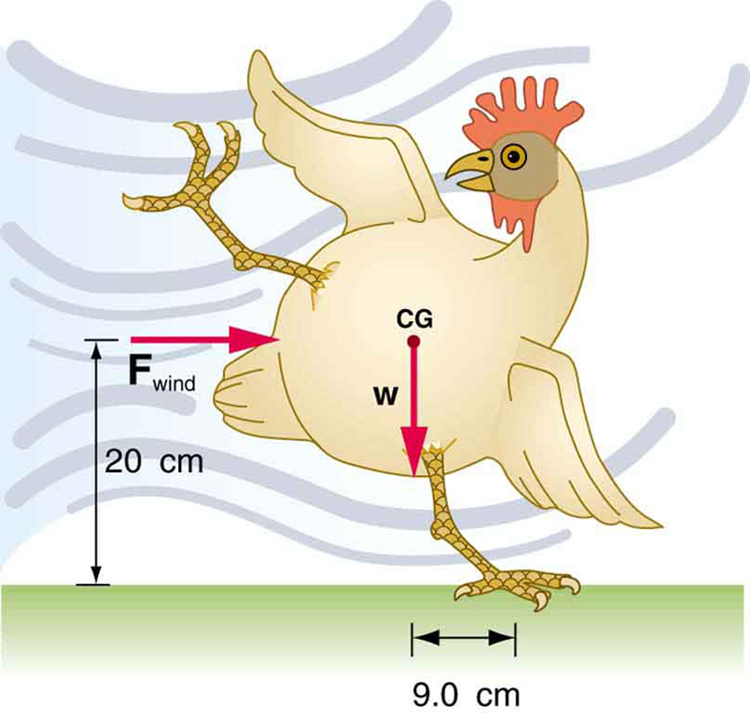| << Chapter < Page | Chapter >> Page > |
Engineers and architects strive to achieve extremely stable equilibriums for buildings and other systems that must withstand wind, earthquakes, and other forces that displace them from equilibrium. Although the examples in this section emphasize gravitational forces, the basic conditions for equilibrium are the same for all types of forces. The net external force must be zero, and the net torque must also be zero.
Stand straight with your heels, back, and head against a wall. Bend forward from your waist, keeping your heels and bottom against the wall, to touch your toes. Can you do this without toppling over? Explain why and what you need to do to be able to touch your toes without losing your balance. Is it easier for a woman to do this?
A round pencil lying on its side as in [link] is in neutral equilibrium relative to displacements perpendicular to its length. What is its stability relative to displacements parallel to its length?
Explain the need for tall towers on a suspension bridge to ensure stable equilibrium.
Suppose a horse leans against a wall as in [link] . Calculate the force exerted on the wall assuming that force is horizontal while using the data in the schematic representation of the situation. Note that the force exerted on the wall is equal in magnitude and opposite in direction to the force exerted on the horse, keeping it in equilibrium. The total mass of the horse and rider is 500 kg. Take the data to be accurate to three digits.

Two children of mass 20.0 kg and 30.0 kg sit balanced on a seesaw with the pivot point located at the center of the seesaw. If the children are separated by a distance of 3.00 m, at what distance from the pivot point is the small child sitting in order to maintain the balance?
(a) Calculate the magnitude and direction of the force on each foot of the horse in [link] (two are on the ground), assuming the center of mass of the horse is midway between the feet. The total mass of the horse and rider is 500kg. (b) What is the minimum coefficient of friction between the hooves and ground? Note that the force exerted by the wall is horizontal.
a)
b) 0.292
A person carries a plank of wood 2.00 m long with one hand pushing down on it at one end with a force and the other hand holding it up at .500 m from the end of the plank with force . If the plank has a mass of 20.0 kg and its center of gravity is at the middle of the plank, what are the magnitudes of the forces and ?
A 17.0-m-high and 11.0-m-long wall under construction and its bracing are shown in [link] . The wall is in stable equilibrium without the bracing but can pivot at its base. Calculate the force exerted by each of the 10 braces if a strong wind exerts a horizontal force of 650 N on each square meter of the wall. Assume that the net force from the wind acts at a height halfway up the wall and that all braces exert equal forces parallel to their lengths. Neglect the thickness of the wall.

(a) What force must be exerted by the wind to support a 2.50-kg chicken in the position shown in [link] ? (b) What is the ratio of this force to the chicken’s weight? (c) Does this support the contention that the chicken has a relatively stable construction?

Suppose the weight of the drawbridge in [link] is supported entirely by its hinges and the opposite shore, so that its cables are slack. (a) What fraction of the weight is supported by the opposite shore if the point of support is directly beneath the cable attachments? (b) What is the direction and magnitude of the force the hinges exert on the bridge under these circumstances? The mass of the bridge is 2500 kg.

a) 0.167, or about one-sixth of the weight is supported by the opposite shore.
b) , straight up.
Suppose a 900-kg car is on the bridge in [link] with its center of mass halfway between the hinges and the cable attachments. (The bridge is supported by the cables and hinges only.) (a) Find the force in the cables. (b) Find the direction and magnitude of the force exerted by the hinges on the bridge.
A sandwich board advertising sign is constructed as shown in [link] . The sign’s mass is 8.00 kg. (a) Calculate the tension in the chain assuming no friction between the legs and the sidewalk. (b) What force is exerted by each side on the hinge?

a) 21.6 N
b) 21.6 N
(a) What minimum coefficient of friction is needed between the legs and the ground to keep the sign in [link] in the position shown if the chain breaks? (b) What force is exerted by each side on the hinge?
A gymnast is attempting to perform splits. From the information given in [link] , calculate the magnitude and direction of the force exerted on each foot by the floor.

350 N directly upwards

Notification Switch
Would you like to follow the 'Physics 110 at une' conversation and receive update notifications?